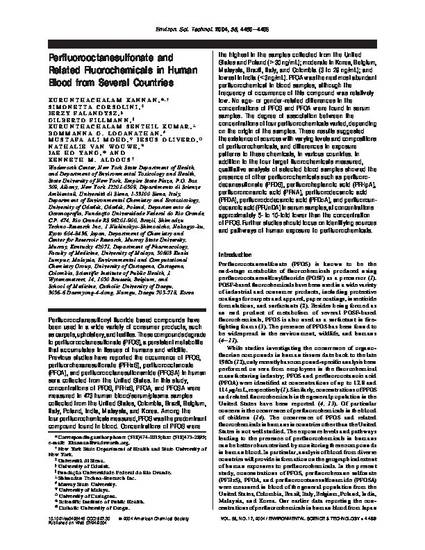
Article
Perfluorooctanesulfonate and Related Fluorochemicals in Human Blood from Several Countries
Environmental Science and Technology
(2004)
Abstract
Perfluorooctanesulfonyl fluoride based compounds have been used in a wide variety of consumer products, such
as carpets, upholstery, and textiles. These compounds degrade to perfluorooctanesulfonate (PFOS), a persistent metabolite that accumulates in tissues of humans and wildlife. Previous studies have reported the occurrence of PFOS, perfluorohexanesulfonate (PFHxS), perfluorooctanoate (PFOA), and perfluorooctanesulfonamide (PFOSA) in human sera collected from the United States. In this study, concentrations of PFOS, PFHxS, PFOA, and PFOSA were measured in 473 human blood/serum/plasma samples collected from the United States, Colombia, Brazil, Belgium, Italy, Poland, India, Malaysia, and Korea. Among the four perfluorochemicals measured, PFOS was the predominant compound found in blood. Concentrations of PFOS were the highest in the samples collected from the United States and Poland (>30 ng/mL); moderate in Korea, Belgium,
Malaysia, Brazil, Italy, and Colombia (3 to 29 ng/mL); and lowest in India (<3 ng/mL). PFOA was the next most abundant perfluorochemical in blood samples, although the frequency of occurrence of this compound was relatively low. No age- or gender-related differences in the concentrations of PFOS and PFOA were found in serum samples. The degree of association between the concentrations of four perfluorochemicals varied, depending on the origin of the samples. These results suggested the existence of sources with varying levels and compositions of perfluorochemicals, and differences in exposure patterns to these chemicals, in various countries. In addition to the four target fluorochemicals measured, qualitative analysis of selected blood samples showed the presence of other perfluorochemicals such as perfluorodecanesulfonate (PFDS), perfluoroheptanoic acid (PFHpA), perfluorononanoic acid (PFNA), perfluorodecanoic acid (PFDA), perfluorododecanoic acid (PFDoA), and perfluoroundecanoic acid (PFUnDA) in serum samples, at concentrations approximately 5- to 10-fold lower than the concentration of PFOS. Further studies should focus on identifying sources and pathways of human exposure to perfluorochemicals.
Disciplines
Publication Date
Summer July 24, 2004
DOI
10.1021/es0493446
Citation Information
Kannan, K., Corsolini, S., Falandyz, J., Fillmann, G., Senthilkumar, K., Loganathan, B.G. et al. 2004. Perfluooctanesulfonate and related fluorochemicals in human blood from several countries. Environ. Sci. Technol. 38, 4489-4495.
